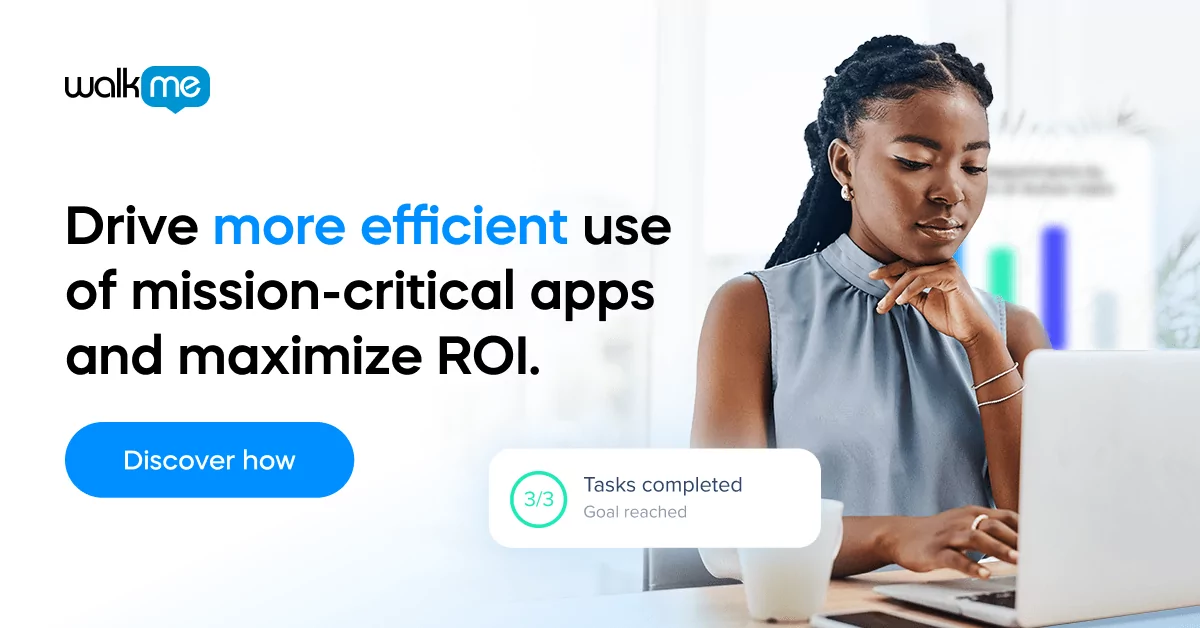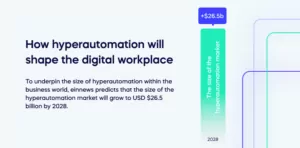Of all the factors influencing the digital workplace in 2023, hyperautomation technology tops the list for saving money and time as well as allowing employees to pursue higher-level tasks. Many technology innovators have repeatedly shown that the methods they use to implement new technologies are inefficient and costly. However, when companies fully utilize the potential of hyperautomation, they can sustain growth in previously impossible ways.
To underpin the size of hyperautomation within the business world, einnews predicts that the size of the hyperautomation market will grow to USD $26.5 billion by 2028.
To help you understand how hyperautomation will shape the digital workplace in 2023, we’ll dive into defining hyperautomation, providing an overview of the digital workplace, and exploring many other factors to optimize your use of hyperautomation for success.
What is hyperautomation?
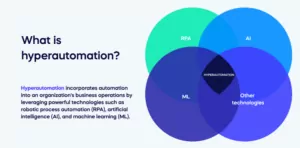
Hyperautomation incorporates automation into an organization’s business operations by leveraging powerful technologies such as robotic process automation (RPA), artificial intelligence (AI), and machine learning (ML). It automates essential processes and procedures without manual intervention by developing a comprehensive automation ecosystem.
However, hyperautomation and automation technologies often get confused. Let’s separate the two by looking at differentiating factors.
Automation vs. hyperautomation
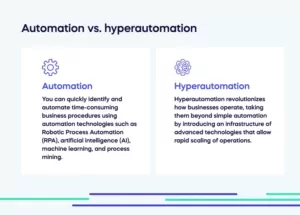
Automation and hyperautomation are similar but different terms, which is why people often confuse the two. Let’s look at both terms separately.
Automation
You can quickly identify and automate time-consuming business procedures using automation technologies such as Robotic Process Automation (RPA), artificial intelligence (AI), machine learning, and process mining. These tools allow businesses to streamline tedious processes to maximize efficiency using regular automation.
Hyperautomation
Hyperautomation revolutionizes how businesses operate, taking them beyond simple automation by introducing an infrastructure of advanced technologies that allow rapid scaling of operations.
In contrast to automation, hyperautomation incorporates technologies that take the automation process one step further, such as AI, machine learning algorithms, and optical character recognition (OCR) to replicate human behavior and intelligence. Hyperautomation enables businesses to carry out intricate tasks requiring humans to input data, analyze information or make decisions.
The role of robotic process automation (RPA), machine learning (ML), and natural language processing (NLP) in hyperautomation
Robotic Process Automation (RPA) leverages computer programs known as software robots to automate tedious and repetitive tasks. To provide a clear example of how RPA works: In manual data entry operations, an employee reads the input forms submitted by customers and then enters that information into a spreadsheet. RPA allows a company to automate the repetitive parts of this process so the employee can concentrate on higher level tasks.
AI and ML have become commonplace in digital workplaces for many years, yet they take on a new level of importance when companies use them as part of emerging hyperautomation technology. While RPA is already integral to this concept, AI is also critical to handling large volumes of unstructured data such as emails, chats, text messages, and purchase orders.
A crucial element of hyperautomation is intelligent automation, which encompasses RPA, natural language processing (NLP), digital process automation, decision management architecture, and intelligent business process management structures (iBPMS).
How hyperautomation plays into digital transformation
Hyperautomation is key to a successful digital transformation as it streamlines processes and optimizes organizational workflows. It speeds up production times, facilitates powerful insights, ensures accuracy, and enhances human decision-making in life science firms. Doing so enables companies to stay agile while successfully meeting their objectives.
With its ability to automate complex tasks such as data analysis, predictive analytics, and more, hyperautomation has become an invaluable tool for companies looking to streamline their operations and maximize profits as part of digital transformation initiatives.
It also enables them to pivot quickly to remain competitive in a rapidly changing market environment. As we move into this new era of automation technology, businesses must equip themselves with strategies to incorporate these tools into their existing workflows to optimize them. To achieve this, examining an overview of the digital workplace is necessary as we consider where hyperautomation fits into our current work environment.
Overview of the digital workplace
To optimize hyperautomation work, it is essential first to give an overview of the digital workplace. Let’s begin with a definition.
What is the digital workplace?

The digital workplace is a virtualized version of your office powered by cloud computing and other tools. Here you can easily use various applications to promote productivity and collaboration. Our State of Digital Adoption report shows what a large part the applications budget plays in developing a successful digital workplace, as most enterprise companies spent an average of USD 31 million on applications in 2022.
The shifting nature of the digital workplace means that the company must modify its environment to optimize its potential. Observing and acting on the top digital workplace trends for 2023 allows companies to focus their investments toward the best technologies to compete and succeed.
Top digital workplace trends for 2023
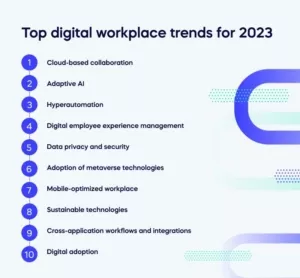
We recently published our list of the top ten strategic workplace trends for 2023, which included:
- Cloud-based collaboration
- Adaptive AI
- Hyperautomation
- Digital employee experience management
- Data privacy and security
- Adoption of metaverse technologies
- Mobile-optimized workplace
- Sustainable technologies
- Cross-application workflows and integrations
- Digital adoption
These are the top digital workplace trends for 2023, but what effect does hyperautomation have on the digital workplace? Let’s find out in the next section.
The current state of hyperautomation technology and its impact on the digital workplace
Recently, hyperautomation has become incredibly popular, and many companies are currently deciding how to implement it into their digital workplace plan.
This approach includes determining which tasks or procedures would benefit from automation, selecting appropriate automation tools for the job, improving them with automated process reuse methods, and expanding their capabilities through various technologies such as AI, analytics process mining, and machine learning.
It is not just in their digital workplaces that companies are looking to implement hyperautomation but also in their digital transformation strategies.
How enterprises are using hyperautomation as part of their digital transformation strategies
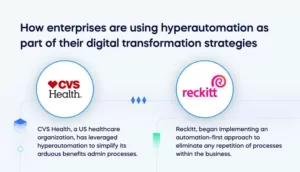
It’s helpful to examine examples of how companies have successfully implemented hyperautomation within their digital transformation strategies. We will look at some of these examples, beginning with CVS Health.
CVS Health: Regulatory risk lowering
CVS Health, a US healthcare organization, has leveraged hyperautomation to simplify its arduous benefits admin processes. The renewed process allows for enhanced efficiency, accuracy, and customer service experiences.
They developed a new system to accelerate processing applications, payments, and issue resolutions using AI, RPA, ML data analytics, and NLP. Previously these cross-functional tasks were largely manual and required analyzing complex data in multiple formats that adhered to specific coding rules. By embracing automation, CVS reduced labor-intensive tasks by automating them, saving time and money.
By leveraging a dynamic workflow, the system quickly manages every step without fail and sends alerts when human support is needed. Doing so has accelerated processes immensely and dramatically reduced the danger of potential human error – an essential task in the heavily regulated healthcare industry.
CVS Health’s agility was drastically enhanced by the system, allowing it to swiftly introduce new programs and products while responding with an agile response to coding practice changes.
Reckitt: Automation efforts in IT
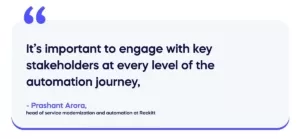
Reckitt, a producer of health, hygiene, and nutrition products, began implementing an automation-first approach to eliminate any repetition of processes within the business. The incentive for this transformation began with IT operations.
“Every department, in any business, has repetition in tasks or processes. We wanted to focus on areas where we saw repetitive work significantly impacting both the team members and user experience,” says Prashant Arora, head of service modernization and automation at Reckitt.
The company started by analyzing its IT suite to identify the tasks taking the longest to solve and consulting with internal stakeholders on what processes they would like automated. “It’s important to engage with key stakeholders at every level of the automation journey,” Arora says.
Now that we have looked at these hyperautomation case studies, let’s look at some more benefits of hyperautomation.
Benefits of hyperautomation to the digital workplace
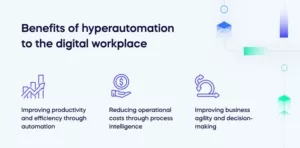
There are many benefits to using hyperautomation in the digital workplace, all of which help companies complete complex tasks faster, saving money and time. They include:
1. Improving productivity and efficiency through automation
Hyperautomation is an excellent tool for businesses to leverage, as it drastically increases employee productivity and efficiency. Rather than wasting time on manual labor related to mundane activities, workers are free to focus their intelligence on high-value tasks that require human input. Meanwhile, hyperautomation allows bots to function around the clock to take over these tedious duties – creating a win/win situation!
Hyperautomation also has numerous advantages over traditional automation procedures, such as:
- Using emerging technologies such as process mining and digital twins, hyperautomation completes complex processes involving unstructured information using cognitive or intelligent automation technologies.
- Rather than just streamlining individual tasks, automation and optimization tools can optimize entire workflows. For example, in recruitment, these solutions can easily take you from job posting to onboarding.
2. Reducing operational costs through process intelligence
Hyperautomation not only diminishes the need for manual labor and avoids costly human error but also grants better visibility into business processes – all of which lead to cost reduction.
It also allows businesses to maximize efficiency, productivity, and accuracy while controlling costs. Through the utilization of cutting-edge technologies such as process mining and the digital twin of an organization (DTO), companies can revolutionize their operations, ultimately increasing efficiency and profits by:
- Visualizing and inspecting in real-time how they carry out processes.
- Identifying bottlenecks, unnecessary steps, and suboptimal parts.
- Redesigning the business processes to optimize and automate them.
3. Improving business agility and decision-making
Hyperautomation is a practical and necessary step for businesses, as it requires the unification of data silos so that multiple systems can function in harmony. This integration process facilitates automation initiatives across all operations – from marketing to finance, sales to HR – ensuring maximum efficiency.
This powerful integration gives businesses an edge as it:
- Offers a comprehensive evaluation of business operations, their interactions, and immediate access to related information.
- Allows organizations to make data-driven decisions to propel their business forward by attaining more in-depth analytical tools.
- Provides a solution to allow businesses to scale and adapt quickly to evolving business conditions.
These are the benefits of hyperautomation, but it is also helpful to consider how hyperautomation accelerated digital adoption and transformation to optimize it fully.
How hyperautomation accelerated digital adoption and transformation
Hyperautomation allows companies to move faster in the digital age by streamlining operations and heightening customer experiences. Combining multiple intelligent technologies will enable businesses to optimize their operational processes and drive service innovation for greater rewards.
Igniting a hyperautomation journey necessitates expertise in many technologies and the insights to optimize end-to-end process optimization.
10 steps to get started with hyperautomation
Follow our ten steps to get your hyperautomation process started. The first step involves attracting buy-in from all your stakeholders.
1. Get buy-in from stakeholders
Stakeholders must be on board for you to undertake your journey with hyperautomation successfully. They must comprehend this technology’s impact and how it could transform operations in the short and long term to benefit the company.
2. Select and evaluate the best tools and partners
Making the wise decision of selecting both a hyperautomation platform and an implementation partner is essential to boosting your business’s performance. Your chosen platform should provide simple integrations as well as robust features.
3. Embrace failure as part of the learning process
A swift response to any losses you may experience will bring you closer to achieving the full potential of hyperautomation.
4. Integration and compatibility
To ensure that your hyperautomation journey remains on budget, avoid substantial changes to your infrastructure. Instead, integrate your existing applications and technology stack, which will be less likely to strain finances.
5. Compliance and security
Comply with regulations and guidelines critical to your industry and business to avoid litigation and harm the company’s reputation.
6. Rigorous testing
As the proverb goes, “prepare for battle in times of peace.” Regular testing is essential to decrease your chances of failure significantly. Doing so will give you enough time to address any problems before they become more serious.
7. Transition planning
When implementing hyperautomation, one of the most challenging aspects is managing change. It’s essential to dispel any employee beliefs that it could lead to redundancies and instead focus on how hyperautomation can help your team dedicate their efforts towards achieving organizational objectives.
Invest in training at the outset of the digital transformation so everyone knows what to expect and has the knowledge to deal with changes.
8. Business continuity and disaster recovery planning
It’s important to know that even digital workers are susceptible to runtime maintenance needs and crashes. You will waste resources if you do not have a backup plan for implementation failure.
And remember: Hyperautomation isn’t immune to outages or disasters; having an emergency management strategy and disaster recovery/business continuity program set up can make all the difference in your journey toward adoption success.
9. Disciplined business case monitoring
To maximize both monetary and non-monetary advantages, it is vital to maintain a close watch on your business case with focus and dedication.
10. Optimizing and evolving the solution
Organizations implementing hyperautomation must frequently update it to remain current.
Hyperautomation, meet DAP
Hyperautomation will usher a change into the digital workplace in 2023. What changes would you like to see in your workplace? How could hyperautomation help you achieve those goals?
WalkMe’s market-leading Digital Adoption Platform (DAP) lets you take advantage of all that hyperautomation has to offer as part of your digital transformation strategy.
Learn more >> https://www.walkme.com/
